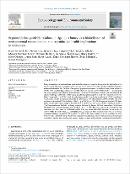| dc.contributor.author | Stuart Ben, Mukiibi | |
| dc.contributor.author | Steven Allan, Nyanzi | |
| dc.contributor.author | Justus, Kwetegyeka | |
| dc.contributor.author | Chijioke, Olisah | |
| dc.contributor.author | Adewale Matthew, Taiwo | |
| dc.contributor.author | Edward, Mubiru | |
| dc.contributor.author | Emmanuel, Tebandeke | |
| dc.contributor.author | Henry, Matovu | |
| dc.contributor.author | Silver, Odongo | |
| dc.contributor.author | Juma John Moses, Abayi | |
| dc.contributor.author | Emily Chelangat, Ngeno | |
| dc.contributor.author | Mika, Sillanp | |
| dc.contributor.author | Patrick, Ssebugere | |
| dc.date.accessioned | 2023-04-24T13:12:47Z | |
| dc.date.available | 2023-04-24T13:12:47Z | |
| dc.date.issued | 2021 | |
| dc.identifier.citation | Mukiibi, S. B., Nyanzi, S. A., Kwetegyeka, J., Olisah, C., Taiwo, A. M., Mubiru, E., ... & Ssebugere, P. (2021). Organochlorine pesticide residues in Uganda’s honey as a bioindicator of environmental contamination and reproductive health implications to consumers. Ecotoxicology and Environmental Safety, 214, 112094. | en_US |
| dc.identifier.uri | https://doi.org/10.1016/j.ecoenv.2021.112094 | |
| dc.identifier.uri | https://hdl.handle.net/20.500.12504/1324 | |
| dc.description.abstract | Honey has multifaceted nutritional and medicinal values; however, its quality is hinged on the floral origin of the nectar. Taking advantage of the large areas that they cover; honeybees are often used as bioindicators of environmental contamination. The focus of the present paper was to examine the quality of honey from within the vicinity of an abandoned pesticide store in Masindi District in western Uganda. Surficial soils (< 20 cm depths) and honey samples were collected from within the vicinity of the abandoned pesticide store and analysed for organochlorine pesticide (OCP) residues using gas chromatograph coupled to an electron capture detector (GC-ECD). The mean level of ∑DDTs in all the soil samples was 503.6 µg/kg dry weight (d.w). ∑DDTs contributed 92.2% to the ∑OCPs contamination loads in the soil samples, and others (lindane, aldrin, dieldrin, and endosulfans) contributed only 7.8%. Ratio (p, p′-DDE + p, p′-DDD)/p, p′-DDT of 1.54 suggested historical DDT input in the area. In all the honey samples, the mean level of ∑DDTs was 20.9 µg/kg. ∑DDTs contributed 43.3% to ∑OCPs contamination loads in the honey samples, followed by lindane (29.8%), endosulfans (23.6%) and dieldrin (3.2%), with corresponding mean levels of 14.4, 11.4 and 1.55 µg/kg, respectively. Reproductive risk assessment was done based on the hazard quotient (HQ) and hazard index (HI) procedure. In our study, the calculated HIs for adults (102.38), and children (90.33) suggested high potential health risks to the honey consumers. Lindane, endosulfan and p, p′-DDD detected in the honey samples at levels exceeding the acute reference dose (ARfD) are known risk factors for spontaneous abortion, reduced implantation, menstrual cycle shortening, impaired semen quality, and prostate cancer in exposed individuals and experimental animal models. | en_US |
| dc.language.iso | en | en_US |
| dc.publisher | Elsevier | en_US |
| dc.subject | Organochlorine pesticides | en_US |
| dc.subject | Honey | en_US |
| dc.subject | Consumers | en_US |
| dc.subject | Reproductive health | en_US |
| dc.subject | Dietary intake | en_US |
| dc.title | Organochlorine pesticide residues in Uganda’s honey as a bioindicator of environmental contamination and reproductive health implications to consumers | en_US |
| dc.type | Article | en_US |

